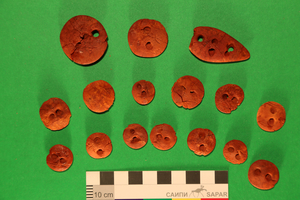An archaeological expedition of PetrSU students discovered a unique primitive burial of an “amber” man
During the next archaeological expedition, students of Petrozavodsk State University under the leadership of Associate Professor Alexander Zhulnikov made a unique discovery. While exploring the ancient sites of the Copperstone Age, located on the western shore of Lake Onega, the expedition discovered a unique burial of an ancient man with many amber jewelry and flint items.
A man of clearly high social status was buried in a narrow oval pit, covered with ritual red paint – ocher. When clearing the grave, about 140 amber jewelry of Baltic origin was found – buttons-stripes, pendants, discs. Earlier, neither in Karelia, nor in the neighboring north-western regions, burials with such a huge amount of amber jewelry were not found. The amber buttons are arranged in rows “face down” and were sewn onto a leather cover that covered the deceased. Along the edges of the grave, amber decorations were located so tightly that they formed two tiers. Some types of amber jewelry found in the burial were previously found only in single specimens in the Eastern Baltic, but not in burials, but during excavations of ancient sites. Judging by the flint tip found nearby, a man was buried in the grave. In the course of a more detailed study of the burial, it was possible to record the details of an unusual burial ritual: small flint chips from tools were placed over the body of the deceased, which are clearly so-called votive items – offerings, apparently symbolizing whole knives and arrowheads. On the territory of Karelia, deposits of flint are unknown, therefore ancient people obtained products from such material by exchange. By analogy with similar amber decorations found at the sites of the Eastern Baltic, the age of the open burial is about 5500 years. which are clearly so-called votive products – offerings, apparently, symbolizing whole knives and arrowheads. On the territory of Karelia, deposits of flint are unknown, therefore ancient people obtained products from such material by exchange. By analogy with similar amber decorations found at the sites of the Eastern Baltic, the age of the open burial is about 5500 years. which are clearly so-called votive products – offerings, apparently, symbolizing whole knives and arrowheads. On the territory of Karelia, deposits of flint are unknown, therefore ancient people obtained products from such material by exchange. By analogy with similar amber decorations found at the sites of the Eastern Baltic, the age of the open burial is about 5500 years.
Since the Mesolithic era, in the forest belt of Europe, ancient people buried the dead in ancestral cemeteries. The burial with rich grave goods found in the vicinity of Petrozavodsk is a single one. In addition, some of the discovered amber jewelry found in the grave had not been found in Eastern Europe before. It is possible that a trader from the Eastern Baltic States was buried in the grave, who arrived on the western shore of Lake Onega to acquire (in exchange for amber) slate chopping tools. Workshops for the production of slate axes and adzes are currently being investigated by the university expedition just next to the burial site.
The burial discovered by the expedition of PetrSU testifies to the formation of the so-called “prestigious” primitive economy among primitive people living in Northern Europe, in which jewelry and especially valuable tools were made to maintain the high social status of their owners. Various jewelry and other prestigious items accumulated by some noble hunters are currently found by archaeologists usually in burials.
The “amber” burial discovered by the expedition of Petrozavodsk University testifies to the strong ties of the ancient population of Karelia with the tribes that lived on the southern coast of the Baltic Sea Alexander Mikhailovich Zhulnikov commented on the find.

